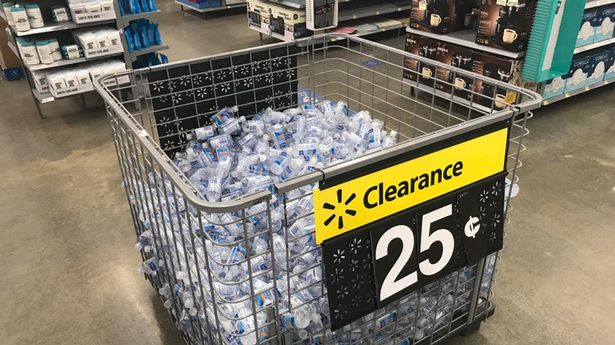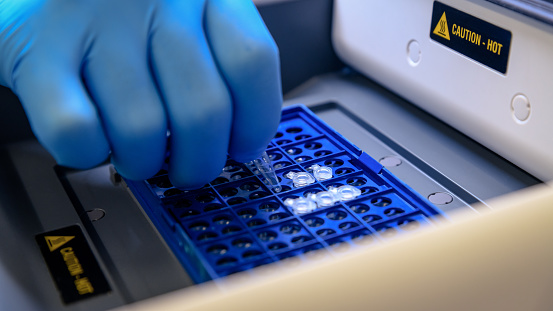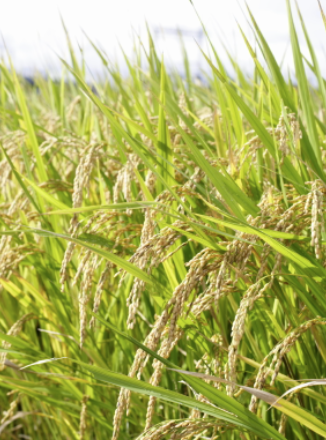 You may have stumbled upon many articles about the poor whales swallowing tons of plastic waste, flooding that is affecting communities and even national parks, or chemicals that are constantly threatening marine life. As the global temperature continues to increase, the ocean levels gradually rise, and life as we know it is threatened, it is almost like we are on our way to the apocalypse. However, humans do not have to accept this doomsday scenario! There are many things beyond our control that we will have to persuade our elected leaders to drastically change policies to conserve our natural resources, reduce pollution, and preserve biodiversity. But there are also many other things well within our control that we can do in the lab and at home to make a difference, since small actions will add up to significant positive change.
You may have stumbled upon many articles about the poor whales swallowing tons of plastic waste, flooding that is affecting communities and even national parks, or chemicals that are constantly threatening marine life. As the global temperature continues to increase, the ocean levels gradually rise, and life as we know it is threatened, it is almost like we are on our way to the apocalypse. However, humans do not have to accept this doomsday scenario! There are many things beyond our control that we will have to persuade our elected leaders to drastically change policies to conserve our natural resources, reduce pollution, and preserve biodiversity. But there are also many other things well within our control that we can do in the lab and at home to make a difference, since small actions will add up to significant positive change.
Sustainability Begins with Organization
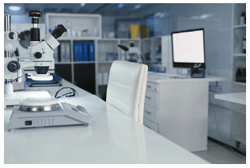 I will harp on this until the end of time, but having an optimally organized laboratory does wonders to saving resources and money! By designating specific spots for equipment and consumables, training lab personnel to maintain the organization system and report when supplies are running low, and developing behaviors to conserve resources through efficient use, your lab will generate less waste and have fewer reagents degrade or get past their expiration dates. It’s annoying when your lab mates buy yet another box of pipet tips when you know there are several boxes lying in storage that they didn’t know about!
I will harp on this until the end of time, but having an optimally organized laboratory does wonders to saving resources and money! By designating specific spots for equipment and consumables, training lab personnel to maintain the organization system and report when supplies are running low, and developing behaviors to conserve resources through efficient use, your lab will generate less waste and have fewer reagents degrade or get past their expiration dates. It’s annoying when your lab mates buy yet another box of pipet tips when you know there are several boxes lying in storage that they didn’t know about!
Reusable Options for Lab Work and Cleanup
The nature of bioscience requires that we segregate samples from each other to minimize cross-contamination, but there are still ways to reduce waste. For example, using a mop and bucket can eliminate the need for mountains of paper towels to clean spills. Switching from plastic tubes to glass can also help the environment, as glass can be more effectively washed out and autoclaved for reuse.
If your workflow permits, consider reusable reagent reservoirs made of tougher plastic that can be cleaned and autoclaved repeatedly. If there are bulk solutions that are used by many lab members, also consider setting up a large canister made of glass or tough plastic that can be refilled as needed, and aliquot into designated conical tubes or smaller glass bottles that folks can take to their bench for individual use. Additionally, by switching to less- or non-toxic chemical options (this will require some research on your part, but an example of a quick solution would be using SYBR Green in lieu of ethidium bromide to visualize DNA), you can recycle your lab plastics more safely and effectively. By formulating a workflow to minimizing cross-contamination, the same pipet tip can be employed several times in a process, for example by establishing the order of addition from least concentrated to most concentrated.
Cardboard and plastic packaging can also be repurposed for lab use, either as extra storage boxes or holders for PCR or other reaction setup. Pipet tips are usually delivered in pre-racked boxes, so when the box is empty, you can use the holes as microfuge tube holders. For pipet tips that come in reloadable stacks, the previous racking plastic can be taken out and used on its own as a tube-holder on top of ice in a bucket, or you can fill the pipette box with ice, a dry-ice/alcohol slurry, or even liquid nitrogen before putting the plastic liner back on to keep tubes cold during quick transport. You can check out our previous lab hacks for other ideas to repurpose equipment and supplies, and check out this video for other ideas you might be able to adapt:
From Single-Use to Multi-Use
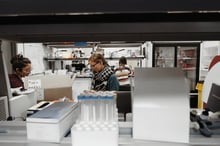 Recycling may be difficult because of the incompatibility of certain lab plastics with local recycling plants, as well as the risk of contamination, but services do exist. If they are not contaminated by toxic or biological waste, your nitrile gloves can be recycled in bulk. You can also purchase your tips and conical tubes in bulk bags, which directly reduces fuel in transport by being lighter and having less space taken up on the truck or airplane. Re-racking tips and tubes also saves on packaging material and allows you to reuse your old tip boxes.
Recycling may be difficult because of the incompatibility of certain lab plastics with local recycling plants, as well as the risk of contamination, but services do exist. If they are not contaminated by toxic or biological waste, your nitrile gloves can be recycled in bulk. You can also purchase your tips and conical tubes in bulk bags, which directly reduces fuel in transport by being lighter and having less space taken up on the truck or airplane. Re-racking tips and tubes also saves on packaging material and allows you to reuse your old tip boxes.
It may be worthwhile to seek out companies that source from recycled materials, and also offer services to recycle their products in an effort to close the supply loop. For example, the company Polycarbin has launched lab plastic product lines that are much more sustainable and efficient using recycled plastics. There are also companies that work with biodegradable plastics, and biological plastics that might not be readily degradable but are at least easily recyclable.
Breaking it Down
Other companies are actually focused on cleaning and reusing plastics in-lab. Grenova has devices that wash used pipet tips so that they can be reused several times in subsequent experiments. There are many research teams focused on breaking down plastics, both consumer products and from lab consumables. One strategy is removing contaminants to facilitate conversion from polymer to monomer and back again, which would ease recycling processes. Another is by using nanotechnology and enzymes to break the plastic down from within after a set time to coordinate with the shelf life of the material within the container.
A small company trying to break down plastics into substances that can be used by the greater ecosystem is Polliloop, the brainchild of two brilliant Hungarian scientists. The bacterial culture used contains some enzyme cocktail that seems to break down any plastic within a matter of weeks versus the decades or centuries otherwise, and the resultant goo is usable as fertilizer. Polliloop’s founders have been fundraising for the past couple years, and have some videos circulating to explain their process and vision.
Working Toward Sustainable Infrastructure
The scientific community, particularly those who work daily in lab and who study ecology and sustainability, is acutely aware of the need to improve recycling and reuse programs. I recall going through mounds of plastic in both graduate research and in production, and it was very distressing knowing that most of this would end up in landfills or possibly in a whale’s belly. European institutions are implementing programs to reduce single-use plastics, and to phase them out completely within the next few years. As more industries realize the importance of sustainability, hopefully the whole world follows their example and we can continue pressuring other companies and leaders to enact policies to make our planet more sustainable, and certainly a lot cleaner!


